1.1 Overview of the Book
“Flour Water Salt Yeast” by Ken Forkish is a highly acclaimed guide to bread making, focusing on the fundamentals of bread baking. With a clear, accessible approach, Forkish shares recipes and techniques for crafting artisan breads, pizzas, and more. The book emphasizes the importance of quality ingredients and precise methods, making it a must-have for both novices and experienced bakers seeking to refine their skills.
1.2 Importance of the Four Basic Ingredients
The four basic ingredients—flour, water, salt, and yeast—are foundational to bread making. Flour provides structure and texture, while water hydrates and develops gluten. Salt enhances flavor and controls yeast activity, ensuring proper fermentation. Yeast ferments sugars, producing carbon dioxide for rise. Together, these elements create a balanced, aromatic loaf, demonstrating their essential roles in achieving exceptional bread quality and character.

The Author: Ken Forkish
Ken Forkish, a James Beard and IACP Award-winning author, is renowned for his expertise in bread making. His book, “Flour Water Salt Yeast,” simplifies artisanal baking for home bakers.
2.1 Background and Expertise
Ken Forkish, a former chef and bakery owner, brings decades of expertise in bread making to his writing. His deep understanding of bread chemistry and technique is evident in “Flour Water Salt Yeast,” where he demystifies complex processes for home bakers. His methodical approach and clear instructions have made the book a trusted resource for both novices and experienced bakers.
2.2 His Approach to Bread Making
Ken Forkish emphasizes simplicity and precision, focusing on the four basic ingredients: flour, water, salt, and yeast. His approach is methodical, breaking down complex processes into clear, achievable steps. He advocates for understanding the chemistry behind bread making and adapting techniques to home environments, ensuring consistent results. Forkish’s techniques balance artistry with practicality, making bread making accessible and rewarding for all skill levels.
The Role of Flour in Bread Making
Flour is the fundamental ingredient in bread making, providing structure and texture. Its protein content, particularly gluten, determines dough elasticity and rise, making it essential for bread quality.
3.1 Types of Flour and Their Characteristics
Flour varies widely, with types like all-purpose, bread, whole wheat, and rye. Each has unique protein content, affecting gluten formation and texture. Bread flour, high in protein, creates chewy bread, while all-purpose flour balances strength and tenderness. Whole wheat adds nutty flavor and fiber, while rye flour contributes earthy notes. Understanding these differences is key to achieving desired bread qualities in recipes like Ken Forkish’s Country Blonde sourdough.
3.2 How Flour Affects Bread Flavor and Texture
Flour significantly impacts bread’s flavor and texture through protein content and grain type. High-protein flours produce chewier, more structured loaves, while lower-protein flours yield tender crumb. Whole grain flours add robust flavors and denser textures, whereas refined flours create lighter, milder bread. Ken Forkish emphasizes flour’s role in achieving the perfect balance of flavor and texture, making it a cornerstone in bread making, as detailed in his book “Flour Water Salt Yeast.”

The Importance of Water
Water is crucial for dough hydration, directly affecting texture and structure. Its quality and temperature influence yeast activity and fermentation, ensuring optimal bread rise and flavor development.
4.1 Water Quality and Temperature
Water quality significantly impacts bread making, as impurities can hinder yeast activity and affect flavor. Using filtered or mineral-rich water is recommended for optimal results. Temperature is equally crucial, with ideal ranges between 75°F and 80°F (24°C to 27°C) for yeast activation. Ken Forkish emphasizes these factors to ensure proper dough hydration and fermentation, leading to better texture and rise in bread.
4.2 Hydration Techniques
Hydration techniques in bread making involve mixing flour and water to achieve the perfect balance for dough development. Ken Forkish emphasizes the importance of proper hydration to create a smooth, elastic dough. Techniques like autolyse (pre-mixing flour and water) and gradual hydration allow for better water absorption and even distribution of ingredients, ensuring optimal dough structure and fermentation. This step is crucial for achieving professional-quality bread.
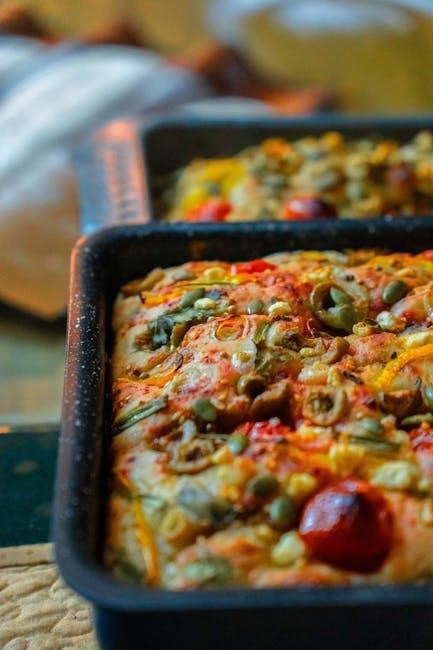
Salt: Its Function in Bread
Salt enhances flavor, controls yeast activity, and strengthens gluten. Essential for balanced taste and proper bread structure, it elevates the quality of the final loaf significantly.
5.1 Role of Salt in Fermentation and Flavor
Salt plays a vital role in fermentation by controlling yeast growth and enhancing bread’s natural flavors. It balances sweetness, strengthens gluten structure, and preserves bread by inhibiting microbial activity. Ken Forkish emphasizes salt’s importance in “Flour Water Salt Yeast,” detailing how it contributes to a more complex and aromatic crumb, making it essential for achieving professional-quality bread at home.
5.2 Best Practices for Using Salt
Best practices for using salt involve precise measurement to avoid overpowering the bread. Add salt after mixing flour and water to ensure even distribution. Use high-quality, unrefined salts for enhanced flavor. Timing is crucial, as salt added too early can inhibit yeast activity. Forkish recommends using 1.5-2% salt relative to flour weight for optimal results in “Flour Water Salt Yeast,” ensuring balanced flavor and texture.
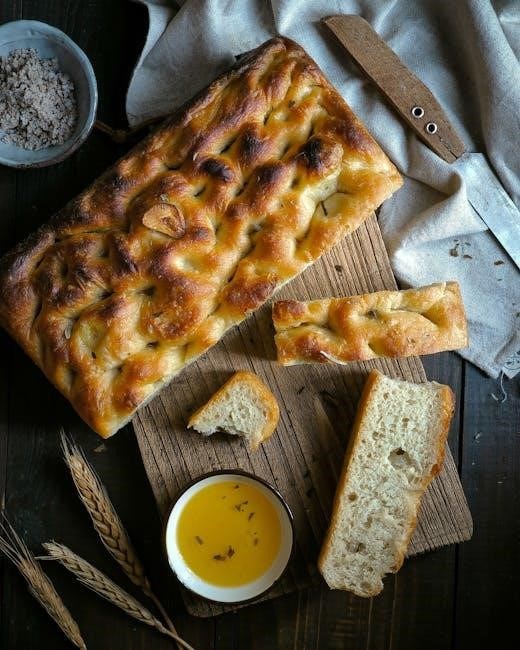
Yeast: The Heart of Bread Making
Yeast is the heart of bread making, enabling fermentation and rise. Ken Forkish explains its role in creating dough structure and flavor in “Flour Water Salt Yeast.”
6.1 Understanding Yeast Fermentation
Understanding yeast fermentation is crucial for bread making. Yeast consumes sugars, producing carbon dioxide, which leavens dough. Ken Forkish explains how temperature, hydration, and yeast type affect this process, ensuring optimal rise and flavor development in “Flour Water Salt Yeast,” helping bakers master fermentation for professional results at home.
6.2 Using Active Dry vs. Instant Yeast
Active dry and instant yeast differ in handling and application. Active dry yeast requires rehydration in warm water before mixing, while instant yeast can be added directly to dry ingredients. Ken Forkish in “Flour Water Salt Yeast” explains that active dry yeast is ideal for bread machines or recipes needing longer rise times, whereas instant yeast offers convenience for home bakers seeking quicker fermentation processes.
Basic Bread-Making Techniques
Bread making involves mixing, dough development, fermentation, shaping, and baking. These essential steps ensure proper texture and flavor, forming the foundation for creating various bread types.
7.1 Mixing and Dough Development
Mixing combines flour, water, salt, and yeast, initiating fermentation. Proper hydration ensures even distribution, while gentle folding or kneading develops gluten for structure and elasticity. This step is crucial for achieving the desired dough consistency and texture. Techniques like autolyse or stretch-and-fold enhance dough strength without overworking it. Forkish emphasizes the importance of patience and observation during this foundational process to create a balanced, responsive dough.
7.2 Fermentation and Proofing
Fermentation is where yeast transforms sugars into carbon dioxide, giving bread its rise. Proofing involves allowing the dough to rest and expand after shaping. Temperature and time are critical; warmer environments speed up fermentation, while cooler ones slow it down. Forkish stresses monitoring the dough’s expansion to ensure it reaches optimal volume without over-proofing, which can lead to a dense final product.
7.3 Shaping and Baking
Shaping involves gently handling dough to preserve air pockets, ensuring a light texture. Baking requires preheating the oven to high temperatures (often 450°F) and using steam for a crisp crust. Scoring the dough before baking allows controlled expansion and enhances appearance. Forkish emphasizes proper oven preparation and timing to achieve perfectly baked bread with a golden, caramelized crust and a tender interior.
Popular Recipes from the Book
The book features iconic recipes like Saturday White Bread and Country Blonde Sourdough, offering bakers timeless, approachable formulas for delicious homemade bread;
8.1 Saturday White Bread
Saturday White Bread is a beloved recipe from the book, offering a simple yet flavorful bread experience. It uses basic ingredients and is designed for a single-day process, making it accessible for bakers of all levels. The recipe emphasizes the importance of proper hydration and mixing techniques, resulting in a soft, airy crumb and a golden crust. Perfect for weekend baking, it remains a fan favorite among home bakers.
8.2 Country Blonde Sourdough
Country Blonde Sourdough is a standout recipe in the book, showcasing the simplicity and depth of sourdough bread. It relies on a natural sourdough starter for fermentation, offering a tangy yet balanced flavor. The dough requires minimal ingredients—flour, water, and salt—yet yields a complex profile. Perfect for those new to sourdough, this recipe exemplifies Forkish’s mastery in creating approachable yet artisanal breads, making it a favorite among bakers.

Sourdough Bread: A Deep Dive
Sourdough bread is a cornerstone of bread making, relying on natural starters instead of commercial yeast. Forkish offers detailed guidance on creating and maintaining these starters, exploring variations and techniques for mastering sourdough.
9.1 Creating and Maintaining a Sourdough Starter
Creating a sourdough starter requires flour and water, mixed and fermented naturally. Forkish details how to cultivate and care for this living ingredient, emphasizing patience and consistent feeding to develop its unique flavor and strength, essential for authentic sourdough bread.
9.2 Sourdough Recipes and Variations
Forkish offers diverse sourdough recipes, from classic boules to whole-grain variations. His Country Blonde sourdough is a standout, blending simplicity with rich flavor. Variations explore different flours, hydration levels, and proofing techniques, encouraging experimentation. Each recipe builds on the sourdough starter, showcasing its versatility and the depth it adds to bread, making it a cornerstone of artisan baking.
Baking Schedules for Home Bakers
Ken Forkish provides adaptable baking schedules to fit busy lives, offering time management tips to ensure homemade bread is achievable for everyone, regardless of their daily routine.
10.1 Fitting Bread Making into a Busy Schedule
Forkish offers practical tips for integrating bread making into hectic lifestyles, emphasizing flexible schedules and time-saving techniques. His approach includes delayed fermentation and make-ahead dough, allowing bakers to adapt recipes to their availability. By breaking down the process into manageable steps, he ensures that even those with limited time can produce high-quality bread without compromising flavor or texture. This chapter is a lifeline for busy home bakers seeking efficiency without sacrifice.
10.2 Time Management Tips
Forkish provides clever time management tips, such as preparing ingredients in advance and utilizing proofing times effectively. He suggests creating a baking schedule that aligns with daily routines, ensuring that each step of the bread-making process fits seamlessly into a busy day. These strategies empower bakers to maximize efficiency while maintaining the quality of their creations, making bread making accessible even for those with tight schedules.
The Science Behind Bread Making
The book delves into the chemistry of bread making, explaining how ingredients interact during mixing, fermentation, and baking. Forkish highlights the role of gluten and yeast activity.
11.1 Chemistry of Dough Development
The chemistry of dough development revolves around gluten formation, yeast fermentation, and hydration. Flour proteins form gluten when mixed with water, creating elasticity. Yeast ferments sugars, producing CO2, which causes dough to rise. Salt enhances flavor and controls yeast activity. The Maillard reaction during baking contributes to crust color and flavor, making the process both scientific and artistic, as detailed in Ken Forkish’s approach.
11.2 Understanding Gluten
Gluten, a protein network in dough, provides elasticity and structure to bread. It forms when flour mixes with water, creating a web that traps air bubbles during fermentation. Proper gluten development ensures a chewy crumb and firm crust. Overworking dough can over-develop gluten, leading to toughness. Bread flours typically have higher gluten content than all-purpose flour, which affects dough strength and rise. Understanding gluten’s role is crucial for achieving the perfect loaf, as explained in Ken Forkish’s guide;
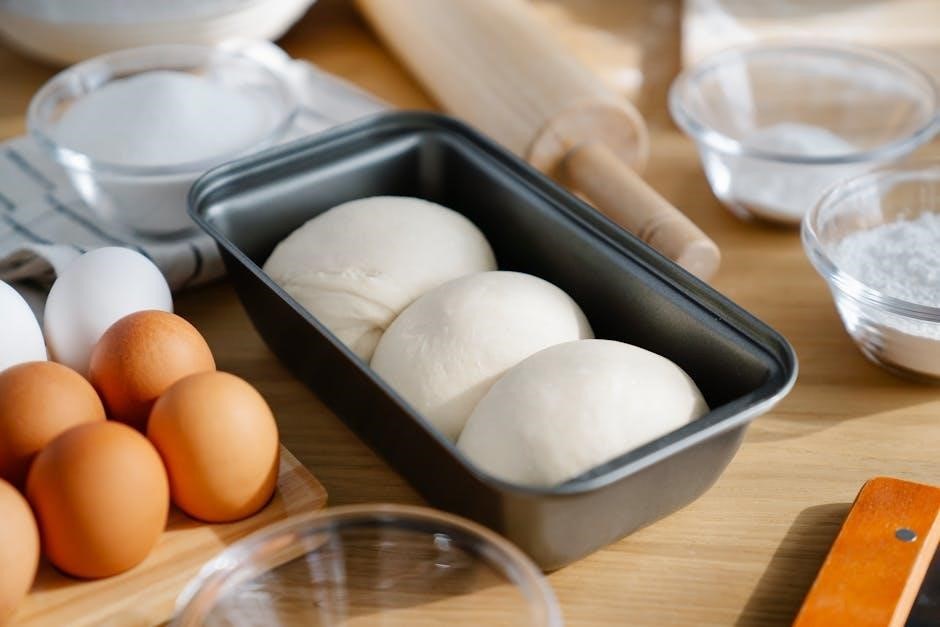
Common Challenges and Solutions
Common challenges in bread making include overmixing dough, incorrect hydration, and poor yeast activity. Solutions involve adjusting techniques, measuring ingredients accurately, and controlling proofing environments for better results.
12.1 Troubleshooting Dough Issues
Troubleshooting dough issues often involves addressing overmixing, incorrect hydration, or yeast inactivity. Adjusting water ratios, ensuring accurate measurements, and maintaining proper temperatures can resolve many problems. Forkish provides practical solutions to common challenges, helping bakers achieve consistent results and improve their craft through careful observation and technique refinement.
12.2 Adjusting Recipes for Different Environments
Environmental factors like humidity, temperature, and altitude can affect bread making. Adjusting recipes may involve tweaking water content, yeast amounts, or proofing times. Forkish provides insights into adapting dough for various conditions, ensuring optimal results regardless of location or climate. Practical tips help bakers modify recipes to suit their specific environments, promoting consistency and success in diverse settings.
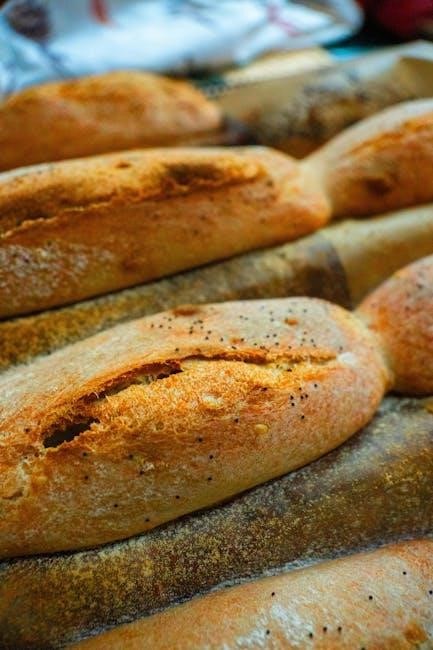
The Book’s Structure and Content
Ken Forkish’s book is structured into 14 chapters, each detailing essential aspects of bread making. It offers a clear, detailed approach, making it accessible to bakers of all levels.
13.1 Chapter-by-Chapter Breakdown
The book is divided into 14 chapters, each focusing on specific aspects of bread making. It begins with the basics of ingredients and techniques, progressing to advanced methods. Chapters cover topics like flour types, hydration, fermentation, and baking schedules. The structure ensures a logical flow, guiding readers from foundational knowledge to mastering complex bread recipes and understanding the science behind bread making.
13.2 Key Takeaways
Readers gain profound insights into bread making, emphasizing simplicity and precision. The importance of quality ingredients and proper techniques is highlighted. Forkish’s approach demystifies complex processes, making artisan bread accessible. The book stresses patience, practice, and understanding the roles of flour, water, salt, and yeast. It’s a valuable resource for both novices and experienced bakers aiming to refine their craft.

Accessing “Flour Water Salt Yeast” in PDF
The book is available in PDF format, offering a convenient way to explore Ken Forkish’s expert techniques. Downloadable from various online platforms, it remains a popular choice for home bakers seeking a comprehensive guide to artisan bread making.
14.1 Where to Find the PDF Version
The PDF version of “Flour Water Salt Yeast” can be found on various online platforms such as Amazon, Google Books, and other digital bookstores. Ensure to download from reputable sources to guarantee quality and authenticity. Additionally, some websites offer free previews or excerpts, allowing readers to sample the content before purchasing the full PDF version.
14.2 Benefits of the Digital Format
The digital format of “Flour Water Salt Yeast” offers unparalleled convenience, allowing readers to access the book on multiple devices. It enables easy searching, bookmarking, and highlighting, enhancing the learning experience. The PDF version is also environmentally friendly, saves physical space, and provides zoom functionality for detailed recipe viewing, making it a practical choice for modern bakers.

Reviews and Reception
“Flour Water Salt Yeast” has received widespread acclaim for its comprehensive approach to bread making, making it a must-have for home bakers and professionals alike.
15.1 What Critics and Readers Say
Critics and readers praise “Flour Water Salt Yeast” as a must-have guide for bread enthusiasts. Reviewers highlight its clear instructions and versatility, making it accessible for both novice and experienced bakers. The PDF version is particularly popular for its convenience, allowing readers to easily reference recipes and techniques. Many have credited the book with transforming their bread-making skills, calling it a timeless resource in the culinary world.
15.2 Impact on Home Baking
“Flour Water Salt Yeast” has revolutionized home baking by simplifying complex techniques and empowering bakers of all levels. Its detailed schedules and adaptable recipes have made artisan bread accessible, even for those with busy lifestyles. The PDF version further enhances convenience, allowing home bakers to easily reference and follow recipes. This book has inspired countless individuals to bake high-quality bread, fostering a deeper appreciation for the craft.
“Flour Water Salt Yeast” is a must-have guide for bread enthusiasts. Ken Forkish simplifies bread making, emphasizing the essence of flour, water, salt, and yeast. Available in PDF, it empowers home bakers to create authentic, high-quality bread with ease and confidence.
16.1 Final Thoughts on the Book
Ken Forkish’s “Flour Water Salt Yeast” is a must-have for bread enthusiasts, offering a detailed yet accessible guide to crafting artisan bread. The book’s structured approach, from basic techniques to advanced recipes, ensures it suits both novices and experienced bakers. Its emphasis on the simplicity of four core ingredients—flour, water, salt, and yeast—demystifies bread making. Available in PDF, it provides convenience and flexibility, inspiring a deeper appreciation for the art of bread crafting. This book is a timeless resource for anyone aiming to master the fundamentals of bread making and elevate their baking skills.
16.2 Encouragement to Start Baking
Embark on your bread-making journey with confidence! Ken Forkish’s “Flour Water Salt Yeast” provides the tools and inspiration to transform simple ingredients into extraordinary bread. Whether you’re a novice or an experienced baker, this book’s clear guidance and adaptable recipes will empower you to create delicious, authentic bread. Start baking today and discover the joy of crafting bread that brings people together!
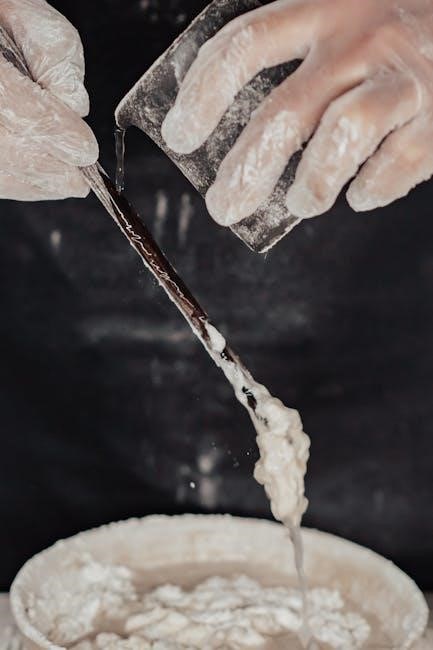



About the author